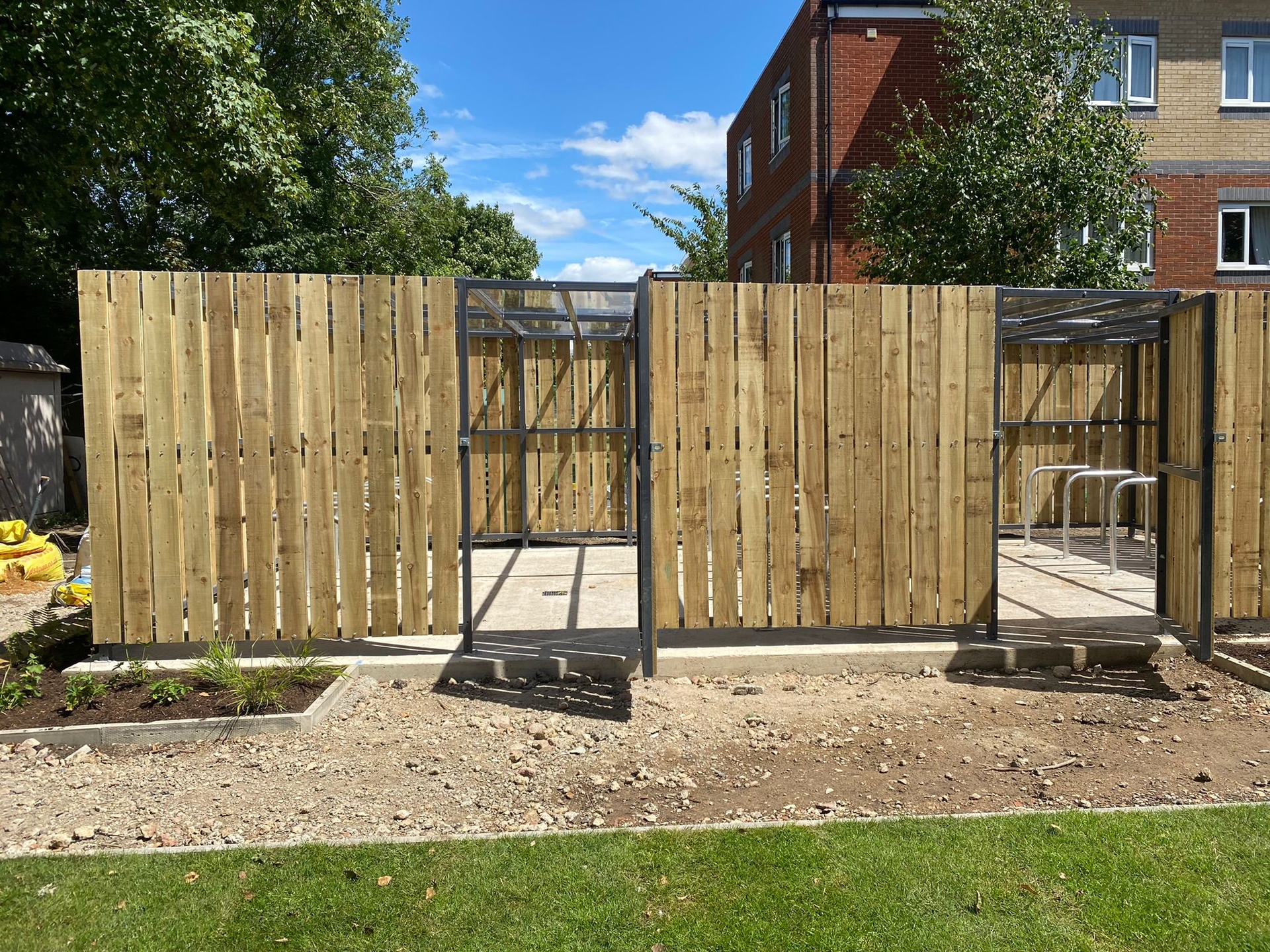The surge in cycling as a preferred mode of transportation, driven by growing environmental consciousness, has emphasised the need for efficient bike storage solutions. Cycling itself is an integral part of being environmentally conscious, and a natural step forward is integrating sustainable materials into cycling infrastructure. This is not just a design trend but a necessity. For the world, sustainable materials help reduce our collective carbon footprint, conserve resources, and mitigate climate change. For our local communities, they promote healthier environments and support green initiatives.
Sustainable Materials
Modern bike shelters and storage designs should, of course, first meet functional requirements – they are made and installed to securely house bikes. However, this doesn’t mean they can’t go the extra mile and help contribute to sustainability. They do that by both encouraging more people to hop on a bike as they know they have a safe place to park it, but also by being constructed from better materials. By incorporating sustainable and eco-friendly materials, these structures can reduce carbon footprints and promote a green lifestyle.
So what do we mean when we say sustainable materials? Sustainable materials have a minimal environmental impact during their lifecycle, from production to disposal. Recycled steel and wood are prime examples. Steel is inherently recyclable and capable of being reused repeatedly without degradation of its properties like durability, strength, and corrosion resistance. The steel recycling process requires less energy and emits fewer greenhouse gases than producing new steel. Wood, when sourced responsibly from well-managed forests, is a renewable resource. It absorbs carbon dioxide as it grows, and its production has a lower environmental impact than synthetic materials.
These materials are used in many ways in bike shelter and storage construction. Recycled steel is often used for structural frames, providing robustness and longevity. It can withstand various weather conditions, ensuring the safety and security of bicycles. Wood is used for aesthetic elements like cladding and sometimes structural components, adding a natural, appealing look that blends well with the outdoors. Treated wood can also enhance durability against the elements, making it a practical choice for external applications.
What Are The Benefits of Using Eco-Friendly Materials
Environmental Impact
Using sustainable materials in bike shelters and racks production significantly reduces environmental impact. Some materials have high embodied energy and contribute to significant carbon emissions during production and transportation. In contrast, sustainable materials like wood and steel have lower embodied energy and can sometimes be sourced locally, minimising transportation emissions.
Surprising to many, steel is one of the most sustainable materials on the planet. It is permanent, has a long life and can be recycled indefinitely without using its strength and durability. It is also non-toxic and harmful to humans and the environment.
Resource Efficiency
Sustainable materials are often derived from recycled, renewable or specially managed sources, which helps conserve natural resources. For instance, sustainable wood is derived from sustainably managed forests, which means that trees are cut down and planted at a rate that maintains the health and vitality of the forest.
Meanwhile, steel is often recycled, which not only diverts waste from landfills but also requires less energy than virgin steel.
Durability and Maintenance
Many sustainable materials offer superior durability and require less maintenance. This means long lifespans of bike shelters and storage units and less need for frequent replacements and repairs, further conserving resources and reducing waste.
Aesthetics
Natural wood provides a beautiful, warm appearance that enhances the visual appeal of bike shelters, making them more inviting for users. Sometimes, clients want the wooden look so that a shelter can blend in better with the environment. Meanwhile, the cool look of galvanised steel has that industrial and heavy-duty look that is desirable in many places. To add to that, shelters made of steel can easily be painted in a RAL colour to further customise them.
Encouraging Sustainable Transportation
By providing eco-friendly bike storage solutions, cities and organisations also encourage more people to choose cycling over cars. This shift reduces traffic congestion and pollution and promotes healthier lifestyles.
Examples
The Recycle Shelter 20 Bike Shed
The Recycle Shelter 20 Bike Shed exemplifies the use of sustainable materials in bike storage design. This shelter has a strong steel frame and sustainably sourced wood cladding. It is a great example of combining durability with eco-friendliness. Key benefits include:
- Reduced Carbon Footprint: The use of sustainable and easily recyclable materials lowers the shelter’s overall carbon footprint.
- Weather Resistance: Steel components are highly resistant to weather conditions and corrosion, ensuring longevity and minimal maintenance.
- Aesthetic Appeal: The design incorporates a modern aesthetic using materials that align with environmental sustainability goals.
This bike shelter is available in several sizes to house 10, 20 or 30 bikes.
The Recycle Bike Stand
Another innovative example is the Recycle Bike Stand. This product is designed to provide secure bike storage using sustainable materials. Benefits include:
- Eco-friendly Production: Made from recycled materials, the bike stand supports waste reduction and resource conservation.
- Durability: The stand’s materials are chosen for their strength and resilience, ensuring it can withstand daily use without degrading.
- Versatility: Suitable for various environments, from urban settings to parks, it demonstrates how sustainable design can be both practical and versatile.
Integrating sustainable and eco-friendly materials in the construction of bike shelters and bike storage is crucial for promoting environmental sustainability and enhancing urban living. Examples like the Recycle Shelter 20 Bike Shed and the Recycle Bike Stand illustrate such designs’ practical and aesthetic benefits. Modern bike storage solutions can play a pivotal role in fostering sustainable transportation and greener cities by prioritising resource efficiency, durability, and reduced environmental impact.
